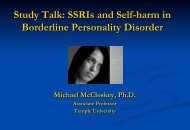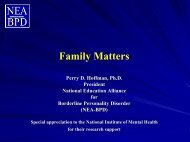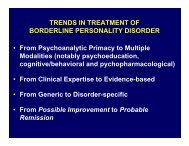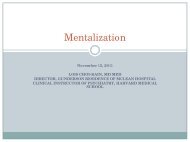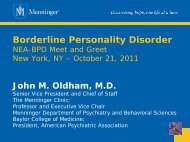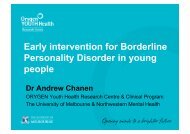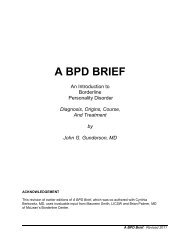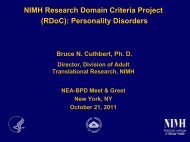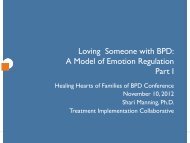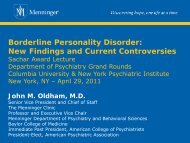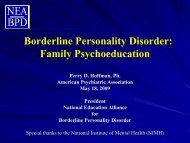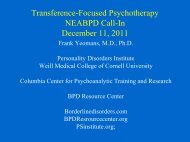Unraveling the Mystery of Borderline Personality Disorder
Unraveling the Mystery of Borderline Personality Disorder
Unraveling the Mystery of Borderline Personality Disorder
You also want an ePaper? Increase the reach of your titles
YUMPU automatically turns print PDFs into web optimized ePapers that Google loves.
<strong>Unraveling</strong> (some <strong>of</strong>) The <strong>Mystery</strong><strong>of</strong> <strong>Borderline</strong> <strong>Personality</strong><strong>Disorder</strong>Have we been barking up <strong>the</strong> wrong tree?Barbara Stanley, Ph.D.Director, Suicide Intervention CenterNew York State Psychiatric InstitutePr<strong>of</strong>essor <strong>of</strong> Clinical PsychologyDepartment <strong>of</strong> PsychiatryColumbia University College <strong>of</strong> Physicians & Surgeonsbhs2@columbia.edu
Conceptions <strong>of</strong> <strong>Borderline</strong> <strong>Personality</strong><strong>Disorder</strong>: The More Recent Past• "<strong>Borderline</strong>" still means different things to different people and d stilltends to be a wastebasket diagnosis and should not be used.• “The families <strong>of</strong> <strong>the</strong> borderline patients were distinguished by <strong>the</strong> trigid tightness <strong>of</strong> <strong>the</strong> marital bond to <strong>the</strong> exclusion <strong>of</strong> <strong>the</strong> attention,support, or protection <strong>of</strong> <strong>the</strong> children. This pattern <strong>of</strong> neglect (by <strong>the</strong>mo<strong>the</strong>r) results in borderline personality in <strong>the</strong> children.”• “Mo<strong>the</strong>rs <strong>of</strong> borderlines tended to conceive <strong>of</strong> <strong>the</strong>ir childrenegocentrically, as need-gratifying objects, ra<strong>the</strong>r than as individualswith distinct and evolving personalities.” The“borderlinephrenegenic”” mo<strong>the</strong>r?• “The diagnosis <strong>of</strong> borderline does not exist. These patients can bestbe considered atypical depressives. Treating <strong>the</strong> depressionsuccessfully resolves most <strong>of</strong> <strong>the</strong> symptoms <strong>of</strong> borderlinepersonality disorder.”• Clinical description and treatment development• Pioneering efforts at understanding <strong>the</strong> neurobiology (Siever(et al.)
The High Risk Nature <strong>of</strong> BPD• Nearly 10% rate for suicide completion inindividuals with BPD• Of all completed suicides, 9-33% 9 33% are byindividuals with BPD• Non-Suicidal Self-Injury: Up to 75% <strong>of</strong>individuals with BPD have cut, burned, hit,or o<strong>the</strong>rwise injured <strong>the</strong>mselves
What is BPD?DSM IV Criteria• Frantic efforts to avoid real or imagined abandonment• Unstable and intense interpersonal relationships• Identity disturbance: markedly and persistently unstable self-imageor sense <strong>of</strong> self• Impulsivity in at least two areas that are potentially self-damaging(e.g., spending, sex, substance abuse, reckless driving, bingeeating).• Recurrent suicidal behavior, gestures, or threats, or self-mutilatingbehavior• Affective instability due to a marked reactivity <strong>of</strong> mood (e.g., intenseepisodic dysphoria, , irritability, or anxiety usually lasting a few hours,rarely > few days).• Chronic feelings <strong>of</strong> emptiness• Inappropriate, intense anger or difficulty controlling anger• Transient paranoid feelings or severe dissociative symptoms
Symptom Clusters in BPDFactor analytic studies have identified threesymptom clusters:• Disturbed Interpersonal Relatedness –Interpersonal turbulence and identity disturbance• Behavioral Instability – Impulsivity, Aggression,Self-Injurious and Suicidal Behavior• Emotional Instability – Emotion Dysregulation,Depressed Mood and Intense EmotionalReactions
Co-Occurring <strong>Disorder</strong>s• Depression and Dysthymia• Bipolar disorder• Substance abuse• Eating disorders• Post traumatic stress disorder• Panic/anxiety disorders• Attention deficit disorder• Dissociative Identity <strong>Disorder</strong>• O<strong>the</strong>r personality disorders
The Experience <strong>of</strong> Depression inBPDStanley & Wilson, 2006
Wilson et al, 2007. Comparing Impulsiveness, Hostility Depression…
Where do <strong>the</strong> interpersonal difficulties <strong>of</strong>individuals with BPD fit in?• Gunderson (2010) argued for a greater focuson interpersonal dysfunction inunderstanding borderline personalitydisorder• The interpersonal dysfunction <strong>of</strong> BPD "<strong>of</strong>fers<strong>the</strong> best discriminators for <strong>the</strong> diagnosis"• Mood shifts and self-destructive behaviors inBPD <strong>of</strong>ten occur in response tointerpersonal triggers
Facial Emotion Recognition(Fertucket al, 2010)• We utilized <strong>the</strong> Reading<strong>the</strong> Mind in <strong>the</strong> Eyes Testto assess sensitivity t<strong>of</strong>acial emotionalexpression in BPD andHealthy Controls.• The test presentsparticipants with thirty-sixpictures <strong>of</strong> <strong>the</strong> area <strong>of</strong> <strong>the</strong>face immediatelysurrounding <strong>the</strong> eyes.Example <strong>of</strong> facial stimuli from <strong>the</strong>Reading <strong>the</strong> Mind in <strong>the</strong> Eyes Test(Baron-Cohen, Wheelwright, Hill, Raste, , & Plumb,2001)1. Playful 2. Comforting3. Irritated 4. Bored
Greater Mind in Eyes Accuracy in BPD(N=23) vs. Healthy Controls (N=92)****** = p < .001
Rejection Sensitivity• The Rejection Sensitivity Questionnaire(RSQ) is a well established and valid self-report measure <strong>of</strong> anxious expectations <strong>of</strong>rejection from significant o<strong>the</strong>rs (Downey& Feldman, 1996)• We administered <strong>the</strong> RSQ to three groupsand compared <strong>the</strong>ir Total RSQ scores
Rejection Sensitivity Scores in BPD (N=25),MDD (N=11), and Healthy Control Groups(N=74)**12.00** = p < .0110.008.006.00BPDMDD no BPDControlError bars: 95% CI
Is <strong>the</strong>re an underlying neurobiological deficitfor <strong>the</strong> interpersonal dysfunction <strong>of</strong> BPD?• We need to do better in our treatments• Medications are, at best, partially effective—SSRIs, anxiolytics, , mood stabilizers,neuroleptics proposed in algorithmic form• Psycho<strong>the</strong>rapy thought to be <strong>the</strong> “treatment<strong>of</strong> choice” but it, too, is only partiallyeffective and is lengthy
Current Treatments Miss <strong>the</strong> Mark
Can we look to new conceptualizations?What do <strong>the</strong> opioids do?• Traditional role in modulating <strong>the</strong> sensory and affectivedimensions <strong>of</strong> pain• Reductions in opioid function has been associated withattachment behavior deficits and anxiety-like responses inanimal models• In many species, <strong>the</strong> soothing and comforting that infantsreceive from maternal grooming and touching is mediatedthrough <strong>the</strong> opioid system .• In human beings, opioids are involved in normal andpathological emotion regulation• in addition to <strong>the</strong>ir more• Thus, <strong>the</strong>re’s reason to think that endogenous opioidsfacilitate normal social functioning
Evidence for an Opioid deficit modelin BPD (Stanley &(Stanley & Siever, , 2010; New & Stanley, 2010)• High rate <strong>of</strong> opiate abuse in borderline personalitydisorder• High rate <strong>of</strong> borderline personality disorder amongpatients seeking substance abuse treatment; forinstance• 44.1% <strong>of</strong> individuals seeking buprenorphinetreatment have BPD• Clinicians have noticed that patients with BPD onlow dose opioids report feeling “normal”
Fur<strong>the</strong>r Evidence for an OpioidDeficit• Prossin et al. (2010) Imaging study• Found differences exist between individualswith BPD and comparison subjects inbaseline in vivo µ-opioidµopioid receptorconcentrations• Differences in BPD in <strong>the</strong> endogenousopioid system response to a negativeemotional challenge.
The Opioids and Self Injury• Cutting is very common in BPD• Self injury in BPD is not suicidal but a means to relievepsychic pain• Many patients report that <strong>the</strong>y do not feel physical pain at<strong>the</strong> moment when <strong>the</strong>y cut <strong>the</strong>mselves• Instead, cutting engenders feelings <strong>of</strong> relief or well-being• One view <strong>of</strong> cutting in BPD is that it represents a method <strong>of</strong>endogenous opioid generation• In this view, individuals with BPD learn to cut <strong>the</strong>mselves,<strong>the</strong>reby releasing opioids• According to this view, cutting is a form <strong>of</strong> self-medication;an attempt to diminish severe intrapsychic distress
An opioid deficit model <strong>of</strong> BPD might explainmore than <strong>the</strong>ir self-injurious behavior• The endogenous opioid system not onlyregulates pain but also has an important rolein social behavior• Their extraordinary difficulties in socialbehavior may also be linked to a preexistingdeficit in endogenous opioids.• This system, through µ-opioidµopioid receptors, hasbeen implicated in regulation <strong>of</strong> emotionaland stress responses
Stress Response and BPD• “[F]unctioning<strong>of</strong> <strong>the</strong> HPA axis in BPD isabnormal, with features <strong>of</strong> dysregulatedfeedback inhibition, which is at timessuppressed…”(Zimmerman &Choi&Choi-Kain, , 2009)• Few studies <strong>of</strong> stress response in BPD(e.g.Simeonet al. 2007)
• TSST elicits significant changes in salivarycortisol, , cardiovascular parameters, andemotional state.• Our modification <strong>of</strong> <strong>the</strong> TSST (mTSST(mTSST), isdesigned to induce less stress than <strong>the</strong>original version and can be safely and validlyutilized in a psychiatric population at high riskfor suicide• An ecologically valid method for assessingsocial stress reactivity in BPD?
Stress Response in BPD
Genetics <strong>of</strong> BPD• Heritability estimates <strong>of</strong> BPD ranges:50 -60%• Consistent with studies on <strong>the</strong> heritability <strong>of</strong>personality traits broadly• Prevailing view is that it is <strong>the</strong> traits or traitclusters, ra<strong>the</strong>r than <strong>the</strong> disorder itself, that isheritable*****
Stress Response in Highly ReactiveAggressive Individuals
Conclusions• We’ve just begun to improve our understanding <strong>of</strong>BPD• We can do better in our treatment approaches• We should consider different neurobiologicalapproaches to BPD• We should consider more in depth study <strong>of</strong> <strong>the</strong>components (e.g. reactive aggression, emotiondysregulation• Tie <strong>the</strong> neurobiological approaches to <strong>the</strong>seconstructs.Thank you



